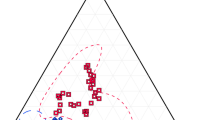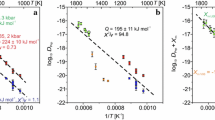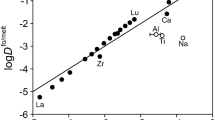Abstract
As a complement to our efforts to update and revise the thermodynamic basis for predicting garnet-melt trace element partitioning using lattice-strain theory (van Westrenen and Draper in Contrib Mineral Petrol, this issue), we have performed detailed statistical evaluations of possible correlations between intensive and extensive variables and experimentally determined garnet-melt partitioning values for trivalent cations (rare earth elements, Y, and Sc) entering the dodecahedral garnet X-site. We applied these evaluations to a database containing over 300 partition coefficient determinations, compiled both from literature values and from our own work designed in part to expand that database. Available data include partitioning measurements in ultramafic to basaltic to intermediate bulk compositions, and recent studies in Fe-rich systems relevant to extraterrestrial petrogenesis, at pressures sufficiently high such that a significant component of majorite, the high-pressure form of garnet, is present. Through the application of lattice-strain theory, we obtained best-fit values for the ideal ionic radius of the dodecahedral garnet X-site, r 0(3+), its apparent Young’s modulus E(3+), and the strain-free partition coefficient D 0(3+) for a fictive REE element J of ionic radius r 0(3+). Resulting values of E, D 0, and r 0 were used in multiple linear regressions involving sixteen variables that reflect the possible influence of garnet composition and stoichiometry, melt composition and structure, major-element partitioning, pressure, and temperature. We find no statistically significant correlations between fitted r 0 and E values and any combination of variables. However, a highly robust correlation between fitted D 0 and garnet-melt Fe–Mg exchange and D Mg is identified. The identification of more explicit melt-compositional influence is a first for this type of predictive modeling. We combine this statistically-derived expression for predicting D 0 with the new expressions for predicting E and r 0 outlined in the first of our pair of companion papers into an updated set of formulae that use easy-to-measure quantities (e.g. garnet composition, pressure, temperature) to predict variations in E, r 0, and D 0. These values are used in turn to calculate D values for those garnets. The updated model substantially improves upon a previous model (van Westrenen et al. in Contrib Mineral Petrol 142:219–234, 2001), and accounts well for trivalent cation partitioning in nominally anhydrous systems up to at least 15 GPa, including for eclogitic bulk compositions and for Fe-rich systems appropriate to magmagenesis on the Moon and Mars. The new model is slightly less successful in predicting partitioning with strongly majoritic garnets, although the mismatch is much less than with the original 2001 model. Although it also improves upon the 2001 model in predicting partitioning in hydrous systems, the mismatch between model and observation is still unacceptably large. The same statistical tools were applied in an attempt to predict tetravalent partitioning as well, because lattice-strain based techniques are not applicable to such partitioning. However, no statistically significant predictive relationships emerged from that effort. Our analyses show that future efforts should focus on filling the gap in partitioning data between ∼10 and 25 GPa to evaluate more closely the gradual transition of garnet to majorite, and on systematically expanding the hydrous partitioning database to allow extension of our model to water-bearing systems.



Similar content being viewed by others
References
Barth MG, Foley SF, Horn I (2002) Partial melting in Archean subduction zones; constraints from experimentally determined trace element partition coefficients between eclogitic minerals and tonalite melts under upper mantle conditions. Precambrian Res 113:323–340
Beard BL, Taylor LA, Scherer EE, Johnson CM, Snyder GA (1998) The source region and melting mineralogy of high-titanium and low-titanium lunar basalts deduced from Lu-Hf isotope data. Geochim Cosmochim Acta 62:525–544
Beattie P, Drake M, Jones J, Leeman W, Longhi J, McKay G, Nielsen R, Palme H, Shaw D, Takahashi E, Watson B (1993) Terminology for trace-element partitioning. Geochim Cosmochim Acta 57:1605–1606
Bennett SL, Blundy J, Elliott T (2004) The effect of sodium and titanium on crystal-melt partitioning of trace elements. Geochim Cosmochim Acta 68:2335–2347
Blichert-Toft J, Gleason JD, Telouk P, Albarede F (1999) The Lu-Hf isotope geochemistry of shergottites and the evolution of the Martian mantle-crust system. Earth Planet Sci Lett 173:25–39
Blundy J, Wood B (1994) Prediction of crystal-melt partition coefficients from elastic moduli. Nature 372:452–454
Carroll MR, Draper DS (1994) Noble gases as trace elements in magmatic processes. Chem Geol 117:37–56
Chauvel C, Blichert-Toft J (2001) A hafnium isotope and trace element perspective on melting of the depleted mantle. Earth Planet Sci Lett 190:137–151
Corgne A, Wood BJ (2004) Trace element partitioning between majoritic garnet and silicate melt at 25 GPa. Phys Earth Planet Inter 143–144:407–419
Dowty E (1980) Crystal-chemical factors affecting the mobility of ions in minerals. Am Mineral 65:174–182
Draper DS, Xirouchakis D, Agee CB (2003) Trace element partitioning between garnet and chondritic melt from 5 to 9 GPa: Implications for the onset of the majorite transition in the Martian mantle. Phys Earth Planet Inter 139:149–169
Draper DS, du Frane SA, Dwarzski RE, Shearer CKJ, Agee CB (2006) High-pressure phase equilibria and element partitioning experiments on Apollo 15 green C picritic glass: Implications for the role of garnet in the deep lunar interior. Geochim Cosmochim Acta 70:2400–2416
Dwarzski RE, Draper DS, Shearer CKJ, Agee CB (2006) Preliminary insights on crystal chemistry of high titanium garnets from partitioning of rare earth and high field strength elements. Am Mineral 91:1536–1546
Fortier SM, Giletti BJ (1989) An empirical model for predicting diffusion coefficients in silicate minerals. Science 245:1481–1484
Gaetani GA (2004) The influence of melt structure on trace element partitioning near the peridotite solidus. Contrib Mineral Petrol 147:511–527
Green TH, Blundy JD, Adam J, Yaxley GM (2000) SIMS determination of trace element partition coefficients between garnet, clinopyroxene and hydrous basaltic liquids at 2–7.5 GPa and 1080–1200 degrees C. Lithos 53:165–187
Hauri EH, Wagner TP, Grove TL (1994) Experimental and natural partitioning of Th, U, Pb and other trace elements between garnet, clinopyroxene and basaltic melts. Chem Geol 117:149–166
Hirschmann MM, Stolper EM (1996) A possible role for garnet pyroxenite in the origin of the “garnet signature” in MORB. Contrib Mineral Petrol 124:185–208
Inoue T, Rapp RP, Zhang J, Gasparik T, Weidner DJ, Irifune T (2000) Garnet fractionation in a hydrous magma ocean and the origin of Al-depleted komatiites; melting experiments of hydrous pyrolite with REEs at high pressure. Earth Planet Sci Lett 177:81–87
Jenner GA, Foley SF, Jackson SE, Green TH, Fryer BJ, Longerich HP (1993) Determination of partition coefficients for trace elements in high pressure-temperature experimental run products by laser ablation microprobe-inductively coupled plasma-mass spectrometry (LAM-ICP-MS). Geochim Cosmochim Acta 57:5099–5103
Johnson KTM (1994) Experimental cpx/ and garnet/melt partitioning of REE and other trace elements at high pressures; petrogenetic implications. Mineral Mag 58A:454–455
Kato T, Ringwood AE, Irifune T (1988) Experimental determination of element partitioning between silicate perovskites, garnets and liquids; constraints on early differentiation of the mantle. Earth Planet Sci Lett 89:123–145
Klein M, Stosch HG, Seck HA, Shimizu N (2000) Experimental partitioning of high field strength and rare earth elements between clinopyroxene and garnet in andesitic to tonalitic systems. Geochim Cosmochim Acta 64:99–115
Klemme S, Blundy JD, Wood BJ (2002) Experimental constraints on major and trace element partitioning during partial melting of eclogite. Geochim Cosmochim Acta 66:3109–3123
Mysen BO (1983) The structure of silicate melts. Ann Rev Earth Planet Sci 11:75–97
Mysen BO, Dubinsky EV (2004) Melt structural control on olivine/melt element partitioning of Ca and Mn. Geochim Cosmochim Acta 68:1617–1633
Nicholls IA, Harris KL (1980) Experimental rare earth element partition coefficients for garnet, clinopyroxene and amphibole coexisting with andesitic and basaltic liquids. Geochim Cosmochim Acta 44:287–308
Onuma N, Higuchi H, Wakita H, Nagasawa H (1968) Trace element partition between two pyroxenes and the host lava. Earth Planet Sci Lett 5:47–51
Pertermann M, Hirschmann MM, Hametner K, Gunther D, Schmidt MW (2004) Experimental determination of trace element partitioning between garnet and silica-rich liquid during anhydrous partial melting of MORB-like eclogite. Geochem Geophys Geosyst 5. doi:10.1029/2003GC000638
Quartieri S, Antonioli G, Geiger CA, Artioli G, Lottici PP (1999a) XAFS characterization of the structural site of Yb in synthetic pyrope and grossular garnets. Phys Chem Minerals 26:251–256
Quartieri S, Chaboy J, Antonioli G, Geiger CA (1999b) XAFS characterization of the structural site of Yb in synthetic pyrope and grossular garnets; 2, XANES full multiple scattering calculations at the Yb, LI- and LIII-edges. Phys Chem Minerals 27:88–94
Quartieri S, Boscherini F, Chaboy J, Dalconi MC, Oberti R, Zanetti A (2002) Characterization of trace Nd and Ce site preference and coordination in natural melanites; a combined X-ray diffraction and high-energy XAFS study. Phys Chem Minerals 29:495–502
Salters VJM (1996) The generation of mid-ocean ridge basalts from the Hf and Nd isotope perspective. Earth Planet Sci Lett 141:109–123
Salters VJM, Hart SR (1989) The hafnium paradox and the role of garnet in the source of mid-ocean-ridge basalts. Nature 342:420–422
Salters VJM, Longhi J (1999) Trace element partitioning during the initial stages of melting beneath mid-ocean ridges. Earth Planet Sci Lett 166:15–30
Salters VJM, Longhi JE, Bizimis M (2002) Near mantle solidus trace element partitioning at pressures up to 3.4 GPa. Geochem Geophys Geosyst 3. 2001GC000148
Shannon RD (1976) Revised effective ionic radii and systematic studies of interatomic distances in halides and chalcogenides. Acta Crystallogr A32:751–767
Shimizu N, Kushiro I (1975) The partitioning of rare earth elements between garnet and liquid at high pressures; preliminary experiments. Geophys Res Lett 2:413–416
Sisson TW, Bacon CR (1992) Garnet/high-silica rhyolite trace element partition coefficients measured by ion microprobe. Geochim Cosmochim Acta 56:2133–2136
Walter MJ, Nakamura E, Tronnes RG, Frost DJ (2004) Experimental constraints on crystallization differentiation in a deep magma ocean. Geochim Cosmochim Acta 68:4267–4284
van Westrenen W, Blundy J, Wood B (1999) Crystal-chemical controls on trace element partitioning between garnet and anhydrous silicate melt. Am Mineral 84:838–847
van Westrenen W, Allan NL, Blundy JD, Purton JA, Wood BJ (2000a) Atomistic simulation of trace element incorporation into garnets; comparison with experimental garnet-melt partitioning data. Geochim Cosmochim Acta 64:1629–1639
van Westrenen W, Blundy JD, Wood BJ (2000b) Effect of Fe2+ on garnet-melt trace element partitioning: experiments in FCMAS and quantification of crystal-chemical controls in natural systems. Lithos 53:189–201
van Westrenen W, Blundy JD, Wood BJ (2001a) High field strength element/rare earth element fractionation during partial melting in the presence of garnet: Implications for identification of mantle heterogeneities. Geochem Geophys Geosys 2. 2000GC000133
van Westrenen W, Wood B, Blundy J (2001b) A predictive thermodynamic model of garnet-melt trace element partitioning. Contrib Mineral Petrol 142:219–234
Wood BJ, Blundy JD (1997) A predictive model for rare earth element partitioning between clinopyroxene and anhydrous silicate melt. Contrib Mineral Petrol 129:166–181
Wood BJ, Blundy JD (2002) The effect of H2O on crystal-melt partitioning of trace elements. Geochim Cosmochim Acta 66:3647–3656
Xirouchakis D, Draper DS, Agee CB (2002) The garnet to majorite transformation in mafic compositions. Lunar Plan Sci XXXIII:abstract#1316
Yurimoto H, Ohtani E (1992) Element partitioning between majorite and liquid; a secondary ion mass spectrometric study. Geophys Res Lett 19:17–20
Acknowledgments
We are grateful to Dr. Charles K. Shearer and Mr. Paul V. Burger for invaluable assistance in performing trace element analyses using the University of New Mexico SIMS facility, and to Mr. Michael Spilde for his help with electron microprobe analyses in UNM’s electron beam laboratory. Journal reviews by an anonymous reviewer and, especially, by Dr. Marc Hirschmann greatly improved this paper. This research was supported by National Science Foundation grant EAR-0337237 to DSD and a European Young Investigator (EURYI) award to WvW.
Author information
Authors and Affiliations
Corresponding author
Additional information
Communicated by T.L. Grove.
Rights and permissions
About this article
Cite this article
Draper, D.S., van Westrenen, W. Quantifying garnet-melt trace element partitioning using lattice-strain theory: assessment of statistically significant controls and a new predictive model. Contrib Mineral Petrol 154, 731–746 (2007). https://doi.org/10.1007/s00410-007-0235-3
Received:
Accepted:
Published:
Issue Date:
DOI: https://doi.org/10.1007/s00410-007-0235-3




